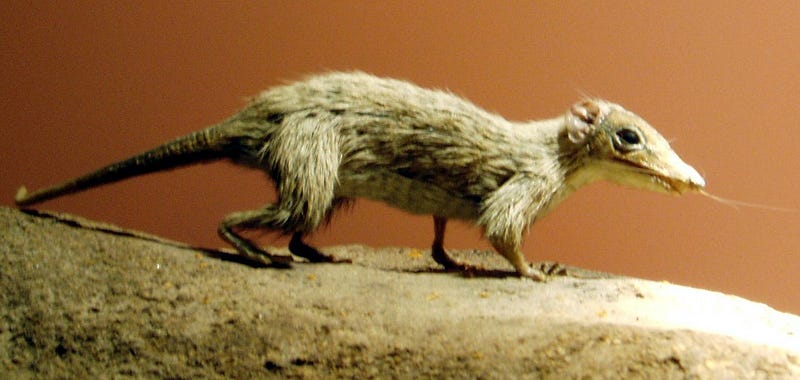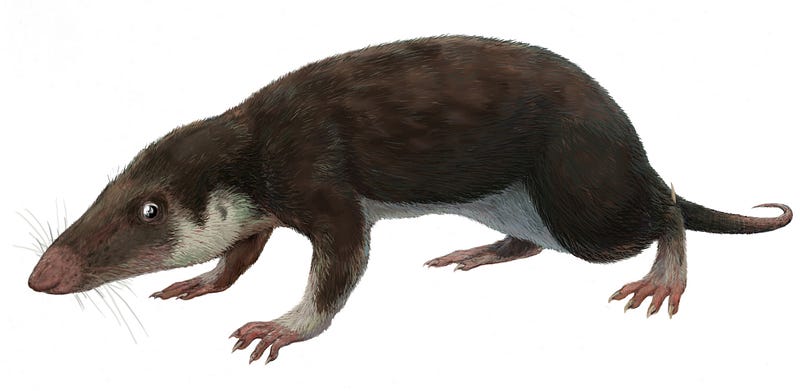Reconstructing the Genome of the Oldest Mammalian Ancestor
Written on
Chapter 1: Understanding Our Mammalian Ancestor
Recent studies analyzing the genomes of 32 modern mammals have led researchers to reconstruct the genetic makeup of their ancient common ancestor. This creature existed approximately 180 million years ago and likely bore a resemblance to the morganucodont, a long-snouted, rat-like early mammal.

The Age of Mammals
The rise of mammals to dominance on Earth commenced around 65 million years ago, following the extinction of the dinosaurs. During this time, small, shrew-like mammals, primarily nocturnal, began to increase in size and diversify, occupying various ecological niches.
These early mammals possessed several key adaptations. Their body structure was conducive to survival; they were furry, with limbs positioned beneath their bodies, unlike reptiles whose limbs extended outward. Living in the shadows of dinosaurs for millions of years allowed these mammals to evolve flexibility, enabling them to swim, dig, climb, and leap. Their minimal dietary needs further enhanced their survival odds during the cataclysmic changes brought about by an asteroid impact.
Mammals vs. Dinosaurs
However, the narrative of mammalian success is often shaped by the victors of history. Before the dominance of dinosaurs, the land was ruled by synapsids, the distant relatives of modern mammals. In contrast, the ancestors of birds and dinosaurs, known as zauropsids, were relatively insignificant in size.
As biologist Joseph LeDoux notes in "The History of Our Consciousness," “zauropsids were no match for synapsids.” From these synapsids arose mammal-like cynodonts, and eventually, true mammals emerged around 210 million years ago. Yet, by this time, formidable predatory dinosaurs had already established dominance both on land and in the oceans, reigning for the next 150 million years.
To survive, mammals had to adapt, becoming smaller and shifting to a nocturnal lifestyle, which led to a partial loss of color vision in favor of improved night vision—a trait that was only fully regained later by primates.
When Did Our Common Ancestor Emerge?
Estimates suggest that the common ancestor of all modern mammals appeared around 180 million years ago, just as early mammals began yielding to the rise of dinosaurs. This ancestor, which is thought to have shared characteristics with the morganucodont, could have been about the size of a rat.
Recent research has unveiled intriguing details about this ancestral creature. Scientists successfully reconstructed its genomic structure by examining the genomes of 32 mammalian species across 23 of the 26 mammalian orders. They identified 1,215 gene blocks that maintain a consistent order on chromosomes across all studied species, indicating the presence of crucial genes necessary for proper embryonic and fetal development.
Interesting Genetic Findings
Further research revealed that modern birds possess a chromosome arrangement analogous to that of the common ancestor of mammals. Joana Damas, the lead researcher, noted, “This remarkable discovery shows that for as long as 320 million years, certain fragments of the genome have remained evolutionarily stable.”
The significance of the 320 million-year timeline is linked to the emergence of amniotes among quadrupeds, marking the development of species that nurture their fetuses in amniotic fluid. This evolutionary path led to both synapsids and zauropsids, the forebears of modern mammals, birds, and reptiles.
Such genomic studies, as part of the Earth BioGenome Project, enhance our understanding of the mechanisms of evolution at the genetic level. This knowledge is crucial in the context of the current sixth mass extinction, aiding efforts to preserve the diverse forms of life on our planet.
Chapter 2: The Largest Horse in History
Although it may seem astonishing, the record holder for the world's largest horse stood over two meters tall and weighed more than 1,500 kilograms!

Thank you for engaging with this article! If you found the content valuable, I would greatly appreciate your support through claps or by following me. Your tips and encouragement mean a lot!